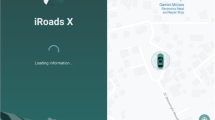Abstract
Based on earlier work [1], this chapter describes two further experiments that can be carried out on the road. It will be explained how to determine the radius of curves and roundabouts of public streets using only a smartphone. The first experiment shows how to determine the radius of a curve by driving a car around the curve while sampling the acceleration data of the car. The second experiment shows how to calculate the radius of a roundabout by using the built-in gyroscope sensor in combination with the acceleration sensor of the smartphone. The same procedure was used by Monteiro et al. (Chap. 18) [2] to examine a merry-go-round.
Access provided by Autonomous University of Puebla. Download chapter PDF
Similar content being viewed by others
Based on earlier work [1], this chapter describes two further experiments that can be carried out on the road. It will be explained how to determine the radius of curves and roundabouts of public streets using only a smartphone. The first experiment shows how to determine the radius of a curve by driving a car around the curve while sampling the acceleration data of the car. The second experiment shows how to calculate the radius of a roundabout by using the built-in gyroscope sensor in combination with the acceleration sensor of the smartphone. The same procedure was used by Monteiro et al. (Chap. 18) [2] to examine a merry-go-round.
1 Determination of a Curve Radius Using the Acceleration Sensors
For this experiment, the smartphone has to be mounted in the car, in order that the two acceleration sensors are correctly aligned—one in the direction of motion and one orthogonal to the direction of motion. To execute the experiment, start the sampling of the acceleration data while the car is in a standstill position. When the car is at a standstill, accelerate to a certain velocity that permits one to move around the bend at a constant speed and radius. The car, as well as the measurement, can be stopped once the curve has been passed. In the following graph you can see the acceleration data as a function of time (Fig. 19.1).
By integrating the acceleration data in the direction of motion over time, you obtain the velocity graph of the car as a function of time (Fig. 19.2).
The relation between velocity and orthogonal acceleration (centripetal acceleration) of a constant circular motion allows us to determine the radius of the curve:
(ac = orthogonal acceleration, v = velocity of the car, r = radius of curve). The following section shows the result of three consecutive measurements including the standard errors of the average means:
The analysis of the curve via Google Maps yields to a radius of 13.7 m and hence agrees with the values determined by the experiment (Fig. 19.3).
2 Determination of the Radius of a Roundabout Using the Acceleration Sensor in Combination with the Gyroscope Sensor
For this experiment, the smartphone has to be aligned in the direction of movement. Afterwards, you sample the data of the gyroscope and acceleration sensor simultaneously while driving around a roundabout with constant speed and radius (Fig. 19.4).
The relation between centripetal force and angular velocity allows the calculation of the radius of the roundabout (Fig. 19.4):
(r = radius, a = centripetal acceleration, ω = angular velocity). Two consecutive measurements lead to the following results
The analysis of the curve via Google Maps yields to a radius of 11.2 m (see Fig. 19.5). Again, the values of the experiment are consistent with the theoretical values determined by the analysis of the roundabout via Google Maps.
Finally it can be concluded that with the two presented methods, curve radii can be determined with sufficient accuracy for educational purposes.
References
Fahsl, C., Vogt, P.: Determination of the drag resistance coefficients of different vehicles. Phys. Teach. 56, 324–325 (2018)
Monteiro, M., Cabeza, C., Marti, A.C., Vogt, P., Kuhn, J.: Angular velocity and centripetal acceleration relationship. Phys. Teach. 52, 312–313 (2014)
Author information
Authors and Affiliations
Editor information
Editors and Affiliations
Rights and permissions
Copyright information
© 2022 The Author(s), under exclusive license to Springer Nature Switzerland AG
About this chapter
Cite this chapter
Fahsl, C., Vogt, P. (2022). Determination of the Radius of Curves and Roundabouts with a Smartphone. In: Kuhn, J., Vogt, P. (eds) Smartphones as Mobile Minilabs in Physics. Springer, Cham. https://doi.org/10.1007/978-3-030-94044-7_19
Download citation
DOI: https://doi.org/10.1007/978-3-030-94044-7_19
Published:
Publisher Name: Springer, Cham
Print ISBN: 978-3-030-94043-0
Online ISBN: 978-3-030-94044-7
eBook Packages: Physics and AstronomyPhysics and Astronomy (R0)









